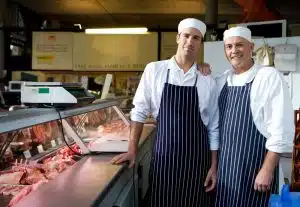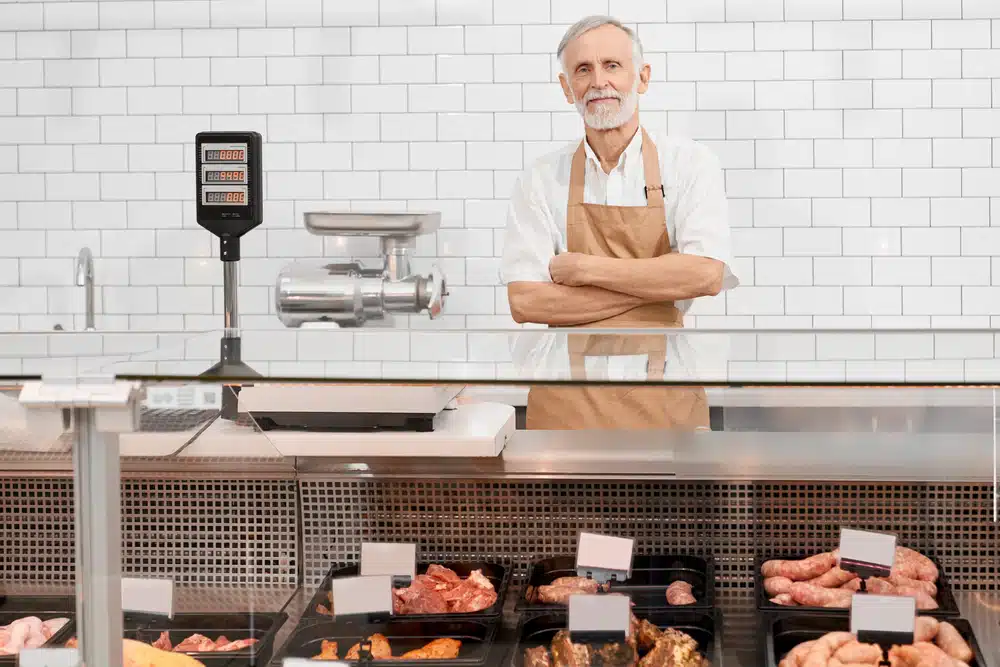
High Street convenience stores have been launched by many supermarket chains in the 2010s, offering a limited range of fresh meat, further stressing the independent sector. Since the economic downturn began, many consumers have turned to discounters such as Aldi and Lidl, which have gained market share in the retail meat industry.
The loss of consumer demand has inevitably had a negative impact on independent butchers, resulting in a decline in their numbers. By 2016, there were only 5,240 independents left, with less than 10% of the market, down from more than 20,000 in the 1980s.
Butcher market sector trends
Despite the fact that independent butcher businesses still have room in the market, many surviving businesses have turned to innovation and diversification to differentiate themselves.
It was during this period, when beef and lamb prices were very high, that meat consumption patterns were affected by the economic downturn. Many consumers therefore substituted cheaper meats, such as chicken, for the higher-priced meats. Due to the Brexit vote in June and negotiations for leaving the EU, the situation worsened in 2016 as the economy stalled during the recovery from 2013 to 2015. There was almost no growth in the economy in 2017 and little, if any, improvement is expected in 2018 and 2019.
As a result of various food scandals, such as the horse meat scandal and the discovery that more than 70% of chickens tested positive for campylobacter, retailers and other suppliers were under pressure to reduce the number of chickens contaminated with campylobacter in the supply chain. Especially butchers who sell meat from local farms and other locally sourced products may have benefited from the program, as they can demonstrate the provenance of all of their meat products. The research that linked cancer to red meat (including pork) and processed meats was less helpful, however. Those are meat products that have been preserved, cured, salted, or smoked (such as bacon, sausages, hot dogs, hams, salamis, and pepperoni), but not fresh burgers or mince.
It has been a difficult year for the fresh meat and poultry industry, especially pork sales. Price increases have contributed significantly to any growth in sales value. Bacon and sausage sales are also declining. People have become increasingly interested in quick-cooking, easy-to-prepare meats as a result of their busy lives. In order to increase sales. As the popularity of roasting joints declines, butchers are cutting more muscle into steaks, and selling mini joints, to reflect the decline in popularity of traditional roasting joints. Customers have also enjoyed flat iron steaks, tender tops, ranch steaks, and bistro steaks. As well as cutting steaks more thinly (average 150g instead of 250g), new cuts like flank steaks, and different-sized packs, other changes can be made to make meat (especially high value red meat) more appealing to customers.
In January 2018, 10% of shoppers had bought a meat-free ready meal, according to research. The number of vegetarians in the UK has doubled over the last 25 years. Sales of meat free sausages and pies have been growing among butchers who make their own. For health reasons, consumers are generally reducing their meat consumption, so you might think about making some ‘flexitarian’ products (products that include some meat but up to 35% fruit, vegetables or pulses). It has become increasingly common for butchers to offer a wider variety of products to their customers, such as delicatessen counters and specialty local produce. Gluten-free products are becoming increasingly popular.
IGD, the food and grocery research and training charity, found that customers want convenience foods that don’t require long preparation times and want to spend less time in the kitchen. Due to the pressure on household budgets, they want cuts of meat that are quick to cook and affordable.
To deal in game, butchers do not need a license. It is still necessary for venison dealers in Scotland to have a venison license, but this will generally apply only to wholesalers. It is not necessary for retailers to have a licence if they buy venison only from licensed dealers.
Keeping up to date with developments
You can stay informed about developments in your industry by joining a trade association. Butchers in the UK are represented by National Craft Butchers, which publishes Craft Butcher magazine on a monthly basis. Those in the meat trade north of the border are represented by the Scottish Federation of Meat Traders Association (SFMTA). More information can be found on their websites.
Beef and lamb and pig industries are represented by AHDB Beef and Lamb and AHDB Pork, respectively. A number of practical tools are available on AHDB’s “Meat Trade” and “Pork for Butchers” websites, as well as guidance for those starting out in the trade.
As a trade magazine for the meat industry, Meat Trades Journal (MTJ) covers all aspects of the trade, such as production, legal issues for butchers, manufacture, wholesale and retail. The website ‘meatinfo’ provides further information.
Trade shows
A trade show or exhibition focusing on butchery and catering will provide you with a lot of useful information. You will be able to find out what types of machinery would be suitable for your business and what the costs would be. For anyone looking to expand their knowledge in the meat, poultry and seafood industry, attending one of the many trade shows found throughout the United Kingdom is an excellent idea.
UK trade shows have some of the freshest and most unique products available, as well as a plethora of educational opportunities related to these industries. Attendees can find seminars focused on trends and new technologies, as well as tastings of different specialty meats. Networking with professionals in the field is also a great way to look ahead at what’s to come in this influential industry.
With all of these offerings, it’s easy to see why UK meat, poultry, seafood trade shows remain popular year after year. It is possible that you will find trade shows that are of interest to you on the ‘pork for butchers’ and Exhibitions UK websites.
Conclusion
With the rise of sustainability, organic, and locally-sourced food trends, butchers are being forced to adjust and modernise their services in order to keep up with current market demands. Butchers now have a unique opportunity to differentiate themselves from larger food shops by offering products such as dry-aged steaks, artisanal deli meats, and house sausages that may not be available elsewhere.
The convenience and health benefits associated with modern butcheries have only propelled their popularity further – with custom cuts using healthy trim levels becoming increasingly in demand. With this trend continuing to stay strong, butchery is sure to remain an integral part of our overall culinary landscape.
Lee Jones is a seasoned Business Finance Specialist with over two decades of invaluable experience in the financial sector. With a keen eye for market trends and a passion for helping businesses thrive, Lee has become a trusted advisor to countless organizations seeking to navigate the complexities of finance.


